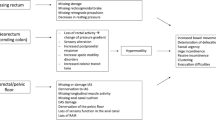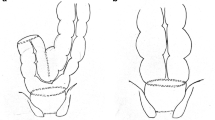Abstract
The aim of this review is to characterize the functional results and “anterior resection syndrome” (ARS) after sphincter-saving surgery for rectal cancer. The purpose of sphincter-saving operations is to save the anal sphincters by avoiding the need for rectal abdomino-perineal resection with a permanent stoma. A variety of alternative techniques have been proposed and, today, ultra-low anterior resections of the rectum are commonplace. Inevitably rectal resections modify anorectal physiology. The backdrop of the functional asset for ultralow anterior resections is related to a small neorectal capacity with high endo-neorectal pressures that act together on a weakened sphincteric mechanism. Sometimes a defecation disorder called ARS may be induced and the patient experiences an extremely low quality of life. Impaired bowel function is usually provoked either by colonic dysmotility, neorectal reservoir dysfunction, anal sphincter damage or by a combination of these factors. Surgical technique defects can contribute to these possible causes: anastomotic ischemia, short length of the descending colon and stretching of neorectal mesentery may play a role. Unfortunately, there is no therapeutic algorithm or gold standard treatment that may be used for ARS. Nevertheless, it is rational to use conservative therapy first and then resort to surgery. Drugs, rehabilitative treatment and sacral neuromodulation may be used; after failure of conservative methods, surgical treatment can be considered.

Similar content being viewed by others
References
Guillem JG, Chessin DB, Shia J et al (2007) Prospective pathologic analysis using whole-mount sections of rectal cancer following preoperative combined modality therapy. Ann Surg 245:88–93
Martin ST, Heneghan HM, Winter DC (2012) Systematic review of outcomes after intersphincteric resection of low rectal cancer. Br J Surg 99:603–612
Cutait DE, Figliolini FG (1961) A new method of colorectal anastomosis in abdominoperineal resection. Dis Colon Rectum 4:335–342
Mason AY (1972) Trans-sphincteric exposure for low rectal anastomosis. Proc R Soc Med 65:974
Parks AG (1972) Transanal technique in low rectal anastomosis. Proc R Soc Med 65:975–976
Schiessel R, Karner-Hanusch J, Herbst F et al (1994) Intersphincteric resection for low rectal tumours. Br J Surg 81:1376–1378
Kim MK, Lim DJ, Yun SH et al (2001) Ultralow anterior resection and coloanal anastomosis for distal rectal cancer: functional and oncological results. Int J Colorect Dis 16:234–237
Morihiro M, Koda K, Seike K et al (2008) Characteristics findings on defecography according to reconstruction method and defecatory disorders following sphincter-saving surgery for rectal cancer. Int J Colorectal Dis 23:883–892
Kusunoki M, Okamoto T, Yoshikawa H (1996) Defecographic assessment after colonic J pouch-anal anastomosis. Surg Today 26:971–974
De la Fuente SG, Mantyh CR (2007) Reconstruction techniques after proctectomy: what’s the best? Clin Colon Rectal Surg 20:221–230
Pucciani F, Bologna A, Cianchi F, Cortesini C (1993) Anorectal physiology following sphincter saving operations for rectal cancer. Dig Surg 10:33–38
Williamson ME, Lewis WG, Finan PJ et al (1995) Recovery of physiologic and clinical function after low anterior resection of the rectum for carcinoma: myth or reality? Dis Colon Rectum 38:411–418
Bharucha AE (2006) Pelvic floor: anatomy and function. Neurogatroenterol Motil 18:507–519
Stebbing JF, Brading AF, Mortensen NJ (1996) Nitric oxide and the rectoanal inhibitory reflex: retrograde neuronal tracing reveals a descending nitrergic rectoanal pathway in a guinea-pig model. Br J Surg 83:493–498
O’Riordain MG, Molloy RG, Gillen P et al (1992) Rectoanal inhibitory reflex following low stapled anterior resection of the rectum. Dis Colon Rectum 35:874–878
Horgan AF, Molloy RG, Coulter J (1993) Nerve regeneration across colorectal anastomoses after low anterior resection in a canine model. Int J Colorectal Dis 8:167–169
Baek SK, Carmichael JC, Pigazzi A (2013) Robotic surgery: colon and rectum. Cancer J 19:140–146
Williamson MER, Lewis WG, Holdsworth PJ (1994) Decrease in the anorectal pressure gradient after low anterior resection of the rectum. Dis Colon Rectum 37:1228–1231
Seow-Choen F, Goh HS (1995) Prospective randomized trial comparing J colonic pouch-anal anastomosis and straight coloanal reconstruction. Br J Surg 82:608–610
Tonelli F, Garcea A, Batignani G (2005) Different role of the colonic pouch for low anterior resection and coloanal anastomosis. Tech Coloproctol 9:15–20
van Duijvendijk P, Slors JF, Taat CW (2002) Prospective evaluation of anorectal function after total mesorectal excision for rectal carcinoma with or without preoperative radiotherapy. Am J Gastroenterol 97:2282–2289
Oya M, Sugamata Y, Komatsu J et al (2002) Poor neorectal evacuation as a cause of impaired defecatory function after low anterior resection: a study using scintigraphic assessment. Surg Today 32:111–117
Temple LK, Bacik J, Savatta SG et al (2005) The development of a validated instrument to evaluate bowel function after sphincter-preserving surgery for rectal cancer. Dis Colon Rectum 48:1353–1365
Emmersten KJ, Laurberg S (2012) Low anterior resection syndrome score: development and validation of a symptom-based scoring system for bowel dysfunction after low anterior resection for rectal cancer. Ann Surg 255:922–928
Sprangers MA, Velde A, Aaronson NK (1999) The construction and testing of the EORTC colorectal cancer-specific quality of life questionnaire module (QLQ-CR38). European Organization for Research and Treatment of Cancer Study Group on Quality of Life. Eur J Cancer 3:238–247
Ziv Y, Zbar A, Bar-Shavit Y, Igov I (2012) Low anterior resection syndrome (LARS): cause and effect and reconstructive considerations. Tech Coloproctol. doi:10.1007/s10151-012-0909-3
Lee WY, Takahashi T, Pappas T et al (2008) Surgical autonomic denervation results in altered colonic motility: an explanation for low anterior resection syndrome? Surgery 143:778–783
Bassotti G, De Roberto G, Chistolini F et al (2005) Case report: colonic manometry reveals abnormal propulsive behaviour after anterior resection of the rectum. Dig Liver Dis 37:124–128
Lee SJ, Park YS (1998) Serial evaluation of anorectal function following low anterior resection of the rectum. Int J Colorectal Dis 13:241–246
Birnbaum EH, Myerson RJ, Fry RD et al (1994) Chronic effects of pelvic radiation therapy on anorectal function. Dis Colon Rectum 37:909–915
Gervaz P, Rotholtz N, Pisano M et al (2001) Quantitative short term study of anal sphincter function after chemoradiation for rectal cancer. Arch Surg 41:543–551
Nesbakken A, Nygaard K, Lunde OC (2001) Outcome and late functional results after anastomotic leakage following mesorectal excision for rectal cancer. Br J Surg 88:400–404
Lundby L, Krogh K, Jensen VJ et al (2005) Long-term anorectal dysfunction after postoperative radiotherapy for rectal cancer. Dis Colon Rectum 48:1349–1352
Bakx R, Doeksen A, Slors FM et al (2009) Neorectal irritability after short-term preoperative radiotherapy and surgical resection for rectal cancer. Am J Gastroenterol 104:133–141
Halböök O, Påhlman L, Krog M et al (1996) Randomized comparison of straight and colonic J pouch anastomosis after low anterior resection. Ann Surg 224:58–65
Lazorthes F, Chiotasso P, Gamagami RA et al (1997) Late clinical outcome in a randomized prospective comparison of colonic J pouch and straight coloanal anastomosis. Br J Sug 84:1449–1451
Hida J, Yoshifuji T, Tokoro T et al (2004) Comparison of long-term functional results of colonic J-pouch and straight anastomosis after low anterior resection for rectal cancer: a five-year follow up. Dis Colon Rectum 47:1578–1585
Fürst A, Burghofer K, Hutzel L, Jauch KW (2002) Neorectal reservoir is not the functional principle of the colonic J-pouch: the volume of a short colonic J-pouch does not differ from a straight coloanal anastomosis. Dis Colon Rectum 45:660–667
Murphy J, Hammond TM, Knowles CH et al (2007) Does anastomotic techniques influence anorectal function after sphincter-saving rectal cancer resection? A systematic review of evidence from randomized trials. J Am Coll Surg 204:673–680
Brown CJ, Fenech DS, McLeod RS (2008) Reconstructive techniques after rectal resections for rectal cancer. Cochrane Database Syst Rev 16: CD006040
Baker JW (1950) Low end to side rectosigmoidal anastomosis: description of the technique. Arch Surg 61:143–157
Z’graggen K, Maurer CA, Büchler MW (1999) Transverse coloplasty pouch. A novel neorectal reservoir. Dig Surg 16:363–366
Liao C, Gao F, Cao Y et al (2010) Meta-analysis of the colon J-pouch versus transverse coloplasty pouch after anterior resection for rectal cancer. Colorectal Dis 12:624–631
Mantyh CR, Hull TL, Fazio VW (2001) Coloplasty in low colorectal anastomosis: manometric and functional comparison with straight and colonic J-pouch anastomosis. Dis Colon Rectum 44:37–42
Tsang WWC, Chung CC, Kwok SY, Li MKV (2006) Laparoscopic sphincter-preserving total mesorectal excision with colonic J-pouch reconstruction. Ann Surg 243:353–358
Ho YH, Tsang C, Tang CL et al (2000) Anal sphincter injuries from stapling instruments introduced transanally: randomized, controlled study with endoanal ultrasound and anorectal manometry. Dis Colon Rectum 43:169–173
Farouk R, Duthie GS, Lee PW, Monson JR (1998) Endosonographic evidence of injury to the internal anal sphincter after low anterior resection: long term follow-up. Dis Colon Rectum 41:888–891
Brown SR, Seow-Choen F (2000) Preservation of rectal function after low anterior resection with formation of a neorectum. Semin Surg Oncol 19:376–385
Akagi Y, Kinugasa T, Shirouzu K (2012) Intersphincteric resection for very low rectal cancer: a systematic review. Surg Today. doi:10.1007/s00595-012-0394-3
Gamagami R, Istvan G, Cabarrot P et al (2000) Fecal continence following partial resection of the anal canal in distal rectal cancer: long-term results after coloanal anastomoses. Surgery 127:291–295
Pollack J, Holm T, Cedermark B et al (2006) Long-term effect of preoperative radiation therapy on anorectal function. Dis Colon Rectum 49:345–352
Heald B (2008) Autonomic nerve preservation in rectal cancer surgery—the forgotten part of the TME message. A practical “workshop” description for surgeons. Acta Chir Iugosl 55:11–16
Ehrenpreis ED, Chang D, Eichenwald E (2007) Pharmacotherapy for fecal incontinence: a review. Dis Colon Rectum 50:641–649
Hanauer SB (2008) The role of loperamide in gastrointestinal disorders. Rev Gastroenterol Disord 8:15–20
Markland AD, Richter HE, Burgio KL et al (2008) Outcomes of combination treatment of fecal incontinence in women. Am J Obstet Gynecol 199: 699.e1–699.e7
Sze EH, Hobbs G (2009) Efficacy of methylcellulose and loperamide in managing fecal incontinence. Acta Obstet Gynecol Scand 88:766–771
Ho YH, Chiang GM, Tan M, Low JY (1996) Biofeedback therapy for excessive stool frequency and incontinence following anterior resection or total colectomy. Dis Colon Rectum 39:1289–1292
Allgayer H, Christoph FD, Rohde W et al (2005) Prospective comparison of short- and long-term effects of pelvic floor exercise/biofeedback training in patients with fecal incontinence after surgery plus irradiation versus surgery alone for rectal cancer: clinical, functional and endoscopic/endosonographic findings. Scand J Gastroenterol 40:1168–1175
Pucciani F, Ringressi MN, Redditi S et al (2008) Rehabilitation of fecal incontinence after sphincter saving surgery for rectal cancer: encouraging results. Dis Colon Rectum 51:1552–1558
Maris A, Devreese AM, D’Hoore A (2012) Treatment options to improve anorectal function following rectal resection: a systematic review. Colorectal Dis. doi:10.1111/codi.12036
Matzel KE, Stadelmaier U, Bittorf B et al (2002) Bilateral sacral spinal nerve stimulation for fecal incontinence after low anterior rectum resection. Int J Colorectal Dis 17:430–434
Ratto C, Grillo E, Parello A et al (2005) Sacral neuromodulation in treatment of fecal incontinence following anterior resection and chemoradiation for rectal cancer. Dis Colon Rectum 48:1027–1036
Vironen JH, Kairaluoma M, Aalto AM et al (2006) Impact of functional results on quality of life after rectal cancer surgery. Dis Colon Rectum 49:568–578
Digennaro R, Tondo M, Cuccia F et al (2012) Coloanal anastomosis or abdominal resection for very low rectal cancer: what will benefit, the surgeon’s pride or the patient’s quality of life? Int J Colorectal Dis. doi:10.1007/s00384-012-1629-x
Conflict of interest
None.
Author information
Authors and Affiliations
Corresponding author
Rights and permissions
About this article
Cite this article
Pucciani, F. A review on functional results of sphincter-saving surgery for rectal cancer: the anterior resection syndrome. Updates Surg 65, 257–263 (2013). https://doi.org/10.1007/s13304-013-0220-5
Received:
Accepted:
Published:
Issue Date:
DOI: https://doi.org/10.1007/s13304-013-0220-5




